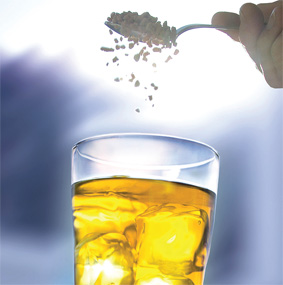 Energy drink market experiences a jolt in sales, but stalls in attracting new customers, reports Mintel
Energy drink market experiences a jolt in sales, but stalls in attracting new customers, reports MintelENERGY drinks/shots manufacturers are having difficulties attracting new customers, despite a 136% increase in sales from 2005-2009, according to exclusive Mintel research. Whilst the research was focused in the United States, the results could help beverage developers anticipate how they can help their brands overcome what is happening in North America: 74% of those surveyed say they don't consume energy drinks/shots, and 69% of those non-users are not interested in trying them. In the region the largest market for energy drinks is in the UAE, where consumers drank about 16.1 million litres of energy drinks in 2009, according to market research analysts Euromonitor International, then valued at about $121.6 million (Dh 446.6 million). By 2014, demand is expected to grow to 29.6 million litres worth $199.8 million. 'Red Bull' is the dominant brand in the UAE, where the brand was launched in 1998 and has an 85% share of the market amongst about 20 brands that include 'Burn' (launched by Coca-Cola in 2007) and 'Monster', the latest brand to be introduced in the Emirates. Mintel's Global Market Navigator (GMN) found that Americans consume 3.05L of energy drinks per capita each year, but energy drink market penetration remained flat at 15% of all adults aged 18+ during 2007-2009. Energy drinks/shots non-users cite high prices (48%), too much caffeine (43%) and a general feeling that energy drinks/shots just aren't good for you (43%) as reasons why they have not consumed any in the past three months. "Sales of energy drinks and shots have remained relatively strong for the last few years, but the same core group of customers continues to buy them," says Garima Goel Lal, senior analyst at Mintel. "The category added only one million new energy drinks users aged 18+ during 2007-2009, compared to 9.3 million new users during 2005-2007, so manufacturers are eager to grow that number again." Sixteen percent of energy drinks non- users and 14% of energy shots non-users would be encouraged to try an energy drink or shot if free samples were offered at a store where they usually shop. Meanwhile, 14% of non-users would be more likely to try energy drinks (11% for energy shots) if they had natural ingredients. "The fact that seven out of 10 people are not interested in the energy drink category suggests the need for manufacturers to develop products aimed at a wider audience," adds Garima Goel Lal. "Providing consumers with more flavors, less sugar and reduced caffeine content are all ways for companies to attract more customers." Seventy-one percent of energy drink users (80% of energy shot users) consume them for an energy boost, 57% of energy drink users employ them to stay awake and 60% of energy shot users say they drink them for mental alertness. Energy drink/shot consumers are more likely to use energy shots (30%) than energy drinks (23%) to enhance sports performance. Sweet and 'smart' sugar Beneo agrees that consumers are looking for more than just a jolt in their energy drinks. Ms Meissner, Corporate Communication manager at Beneo, said at the recent IFT trade show in Chicago, that she expects energy drinks to have more naturally sourced ingredients, including natural, fruit-based flavours. In particular, drinks will provide more balanced, sustained energy rather than cause energy to spike and then rapidly drop, she said. Palatinose, an isomaltulose from Beneo, provides more balanced and steadier energy release, and doesn't cause spikes and lows associated with some sugars used to sweeten energy drinks. Instead, it provides glucose in a more balanced way, supplying energy over a longer period of time It's a 'smart sugar' because it is "the only fully digestible, low glycaemic and tooth-friendly sugar," said Ms Meissner. SteviAIr Jordan Outdoor Basketball Shoes

 iConnectHub
iConnectHub
 Login/Register
Login/Register Supplier Login
Supplier Login


























